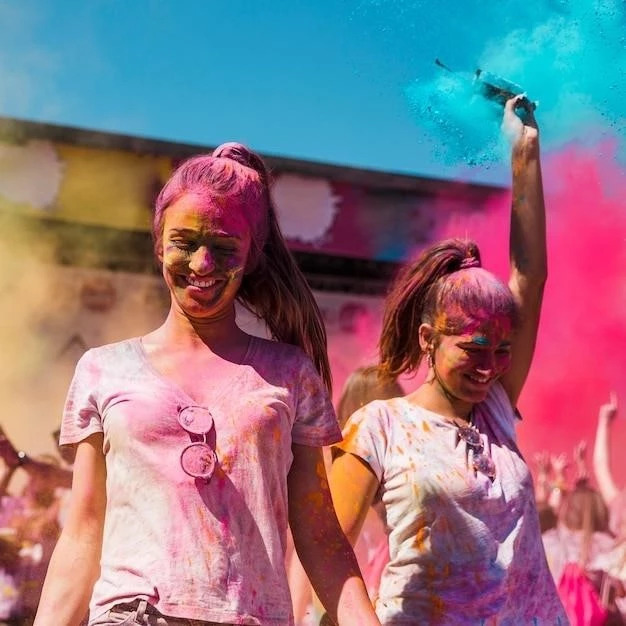A Tapestry of Color: Exploring the World’s Most Vibrant Festivals
Festivals are the lifeblood of cultures worldwide‚ pulsating with vibrant energy‚ dazzling colors‚ and infectious rhythms. They offer a unique window into the heart of a community‚ showcasing its traditions‚ beliefs‚ and artistic expressions. From ancient rituals passed down through generations to modern celebrations of art and music‚ festivals offer a shared human experience that transcends borders and languages.

A Kaleidoscope of Celebrations: Highlighting Diversity and Tradition
Each corner of the globe boasts its own brand of festive magic. Here’s a glimpse into some of the most colorful and vibrant celebrations:
1. Holi (India and Nepal)
Known as the “Festival of Colors” or the “Festival of Love‚” Holi is an ancient Hindu festival celebrating the arrival of spring‚ the triumph of good over evil‚ and the blossoming of love. Participants joyously drench each other in vibrant colored powders and water‚ creating a breathtaking spectacle of unity and joy.
- Key Features: Throwing colored powders (gulal)‚ water balloons‚ street parties‚ traditional sweets and savories.
- Significance: Marks the end of winter‚ celebrates the victory of good over evil (as symbolized by the legend of Holika)‚ and fosters a sense of community.
2. Carnival (Brazil)
Carnival in Brazil is synonymous with pulsating energy‚ flamboyant costumes‚ and the intoxicating rhythms of samba. This pre-Lenten festival transforms cities like Rio de Janeiro into stages for elaborate parades featuring dazzling floats‚ talented dancers‚ and infectious music that captivates onlookers.
- Key Features: Samba parades‚ elaborate costumes‚ street parties (blocos)‚ music and dance competitions.
- Significance: A time for revelry and release before the period of Lent‚ celebrating Brazilian culture and heritage.
3. Yi Peng Lantern Festival (Thailand)
The Yi Peng Lantern Festival in Chiang Mai‚ Thailand‚ is a truly magical spectacle. Thousands of paper lanterns‚ each carrying wishes and prayers‚ are released into the night sky‚ creating a breathtaking display of light and hope. This festival coincides with Loy Krathong‚ where floating baskets adorned with flowers and candles are released onto rivers to symbolize letting go of negativity.
- Key Features: Launching of illuminated paper lanterns (khom loi)‚ floating decorated baskets (krathong) on rivers‚ Buddhist ceremonies‚ traditional dance performances.
- Significance: Paying respect to Buddha‚ making merit‚ and symbolizing the letting go of negativity and misfortune.
4. La Tomatina (Spain)
For a truly unique and messy experience‚ La Tomatina in Buñol‚ Spain‚ is unparalleled. This massive tomato fight draws thousands of participants ready to engage in a playful food fight of epic proportions. For one hour‚ the streets transform into a sea of red as tomatoes fly through the air‚ leaving everyone covered in pulp and laughter.
- Key Features: A massive tomato fight‚ water cannons‚ a ham on a greased pole competition.
- Significance: Though its origins are unclear‚ it has evolved into a celebration of fun‚ camaraderie‚ and letting loose.
5. Día de los Muertos (Mexico)
Día de los Muertos‚ or Day of the Dead‚ is a vibrant and colorful celebration of life and death in Mexico. Families create elaborate altars (ofrendas) adorned with flowers‚ food offerings‚ candles‚ and photos of deceased loved ones. The festival is a time to remember and honor those who have passed on‚ celebrating their lives with music‚ food‚ and joyful remembrance.
- Key Features: Building private and public altars (ofrendas)‚ sugar skulls‚ marigolds‚ pan de muerto (bread of the dead)‚ visits to cemeteries.
- Significance: Remembering and honoring deceased loved ones‚ believing that the spirits of the dead return to visit during this time.

The Significance of Festivals: Threads that Bind Us
Beyond the dazzling colors and joyous celebrations‚ festivals serve a deeper purpose. They are powerful reminders of our shared humanity‚ offering opportunities to:
- Preserve Cultural Heritage: Festivals keep traditions alive‚ passing down customs‚ stories‚ and rituals to younger generations.
- Foster Community Bonding: Celebrations bring people together‚ strengthening social ties and creating a sense of belonging.
- Boost Tourism and Economies: Festivals attract visitors from around the world‚ supporting local businesses and economies.
- Promote Cross-Cultural Understanding: Festivals offer a platform for sharing and appreciating different cultures‚ fostering tolerance and respect.
Experiencing the Magic Firsthand
Attending a festival is an immersive experience that engages all the senses. To fully appreciate the vibrancy and significance of these celebrations‚ consider these tips:
- Plan in Advance: Festivals often draw large crowds‚ so book accommodations and transportation well in advance.
- Research Local Customs: Familiarize yourself with the cultural significance of the festival and any traditional customs or etiquette to show respect.
- Embrace the Spirit: Be open to new experiences‚ engage with locals‚ and immerse yourself in the joyous atmosphere.
- Capture the Memories: Take photos and videos‚ but also be present in the moment and savor the experience.
The world’s most colorful and vibrant festivals are more than just events; they are living expressions of culture‚ history‚ and the human spirit. By experiencing these celebrations firsthand‚ we gain a deeper appreciation for the diversity of our world and the traditions that bind us together.










